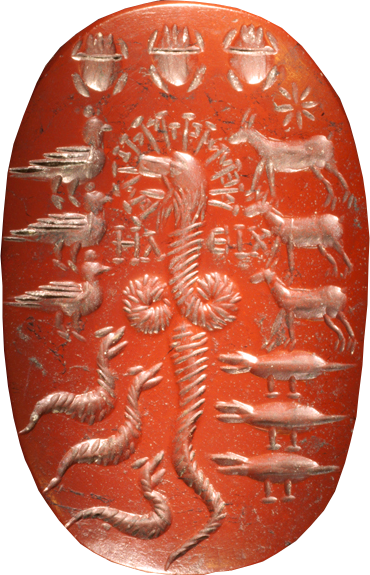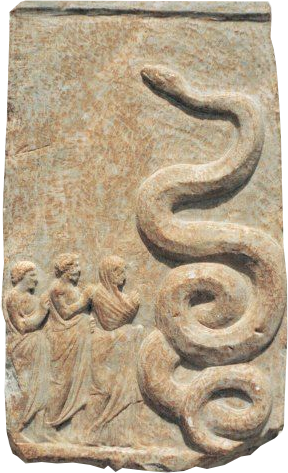Ancient Psychedelia: Alien Gods & Mushroom Goddesses
Online Book - Chapter 11, Page 182
Back to Online Book Mainpage / Next Page (Chapter 11, Page 183)
| The most significant contribution Sabazius made to the future of Christian religion is the hand sign of “benediction,” or the benediction Latina, the first three fingers (thumb to middle finger) upright, the last two curved under. (52) The Greek Zeus Pater is derived from the Sanskrit Diaus Pater, (53) who is the equivalent as well of the Latin Juppiter. He is the father of Ushas, the Goddess of Dawn. Dyaus Pitar and Prithvi were both born from the primordial waters and they gave birth to Indra. (54) Zeus had several epithets including the “fly-catcher” or “Averter of flies.” (55) We should remember, the A. muscaria is called the “fly-agaric,” because of its propensity to attract flies, getting them intoxicated. Another of Zeus’s titles was the “The Agathodaemon,” who was the “God of Good Fortune,” “Good Luck” or “Goodness.” He was considered a noble spirit or beneficial plant or vegetation deity. Frequent representations include the serpent with an occasional halo around the head. This is depicted on many early Greek coins and amulets (39f, reverse). In one case, as depicted on a wall relief dedicated to Zeus Meilichios, c. 4 BC, he is simply a serpent and nothing more (41g). From the site theoi.com: “The Greeks drank a cup of unmixed wine at the end of every repast. A temple dedicated to him was situated on the road from Megalopolis to Maenalus in Arcadia.” Pausanias (viii. 36. § 3) conjectures that the name is a mere epithet of Zeus.” (56) A votive tablet found in the Piraeus, is dedicated to a form of Zeus known as Zeus Meilichios. According to Jane Harrison, this was an earlier form of Zeus, in which he was depicted as a serpent. Harrison points out that this is surprising because … “Zeus is one of the few Greek gods who never appear attended by a snake.” (57) In the Orphic story of Zeus and Rhea, Zeus turns himself into a serpent and mates with a goddess in at least two instances, one of which was Demeter, who was weaving a mantle of wool when she was seduced by Zeus, leading to the birth of Persephone and Dionysos, and another time when he mated with Persephone, producing the short-lived son, Zagreos. (58) |
  R: (41g) Votive relief to Zeus Meilichios Altes Museum, Berlin c. 4 BC Thunderbolts, Arrows and Darts In the Orphic Hymn to Zeus, we read: “Highly honored Zefs, imperishable Zefs, we verily offer you This redemptive testimony and prayer. Oh King, by means of your accomplishment all things are made clear. Earth Goddess mother, and the towering high places of the mountains, The sea, and everything, as many as are arranged within the sky; Kronian Zefs, bearing the scepter, descending in thunder and lightning, strong-hearted one, All-generating Father, origin and end of everything, Earth-shaker, increaser, purifier, shaker of everything, Bearing lightning, thundering and wielding it, yet you are the great nurturer of life. Hear me, God of changeful form. Grant me blameless health, With godly peace, as well as riches and good reputation.” – Orphic Hymn to Zeus (52) Cults of the Roman Empire, p. 319; M.J. Vermasaren (with E. Westra and M.B. de Boer), Corpus cultus Iovis Sabazii (EPRO, 100), I, The Hands, Leiden, 1983; S.E. Johnson, in ANRW, II, 17, 3, p. 1595ff. (53) Hebrew Goddess, p. 31 (54) Cult of the Mother Goddess, p. 111-112; N. Brown, Journal of American Oriental Study, lxii, 1942, p. 85ff (55) Frazer, James George, the Golden Bough (56) Comp. Lobeck, ad Phrynich. p. 603; https://www.theoi.com/Cult/ZeusTitles.html (57) Occidental Mythology, p. 18; Jane Ellen Harrison, Prolegomena to the Study of Greek Religion, p. 19, citing Berlin Museum, Beschreibung der Antiken Skulpturen (58) ibid, p. 27; http://www.theoi.com/Olympios/ZeusLoves.html (39f Reverse) © Genevra Kornbluth |
Go Back to Page 181